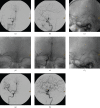Treatment of acute middle cerebral artery occlusion with a Solitaire AB stent: preliminary experience
- PMID: 21088087
- PMCID: PMC3473619
- DOI: 10.1259/bjr/42972759
Treatment of acute middle cerebral artery occlusion with a Solitaire AB stent: preliminary experience
Abstract
We report our initial experience with a Solitaire AB neurovascular remodeling stent device in performing cerebral embolectomy in seven patients presenting to our institution with acute stroke who were resistant to iv thrombolytic drug treatment. The main inclusion criteria were: National Institutes of Health Stroke Scale (NIHSS) score ≥10; treatment performed within 8 h from the onset of symptoms and no large hypodensity on CT; and occlusion of a major cerebral artery on the CT angiogram. An admission and a post-interventional NIHSS score were calculated for all patients by two different neurologists. Efficacy was assessed radiologically by post-treatment thrombolysis in myocardial infarction (TIMI) scores and clinically by a 30-day Modified Rankin Scale (MRS) score. The mean duration of neurointerventional treatment was 84 min. All interventions were successful, with TIMI scores of 2 or 3 achieved in 100% of patients. There was one procedural complication in our series owing to a self-detached stent and one patient had a small asymptomatic basal ganglia haemorrhage. There was improvement of more than 4 points on the NIHSS score in 5 (72%) of the patients following treatment, of whom 4 (57%) had a 30-day MRS score of ≤2. The use of a Solitaire stent in acute stroke was safe, time-efficient and encouraging; however, a larger sample size will be required to further evaluate the use of this device, which could benefit a significant number of stroke patients.
Figures


References
-
- Noser EA, Shaltoni HM, Hall CE, Alexandrov AV, Garami Z, Cacayorin ED, et al. Aggressive mechanical clot disruption. A safe adjunct to thrombolytic therapy in acute stroke? Stroke 2005;36:292–6 - PubMed
-
- Nedeltchev K, Fischer U, Arnold M, Ballinari P, Haefeli T, Kappeler L, et al. Long-term effect of intra-arterial thrombolysis in stroke. Stroke 2006;37:3002–7 - PubMed
-
- Qureshi AI, Siddiqui AM, Suri MFK, Kim SH, Ali Z, Yahia AM, et al. Aggressive mechanical clot disruption and low dose intra-arterial third-generation thrombolytic agent for ischemic stroke: a prospective study. Neurosurgery 2002;51:1319–29 - PubMed
-
- Ueda T, Sakaki S, Nochide I, Kumon Y, Kohno K, Ohta S. Angioplasty after intra-arterial thrombolysis for acute occlusion of intracranial arteries. Stroke 1998;29:2568–74 - PubMed

